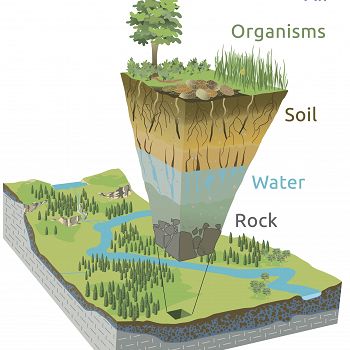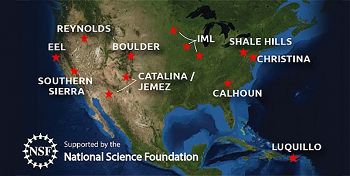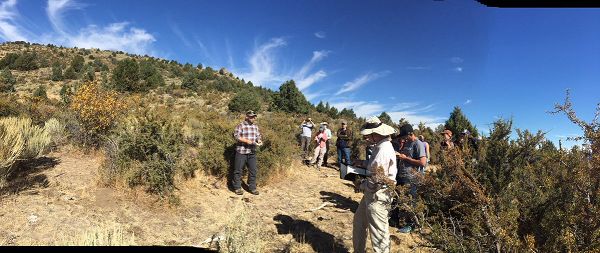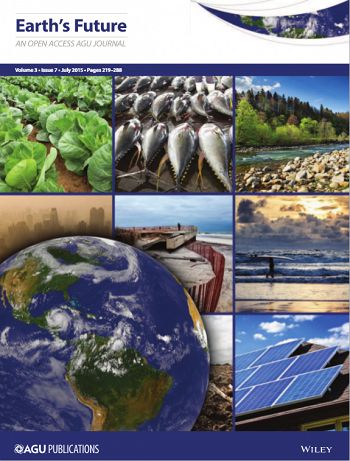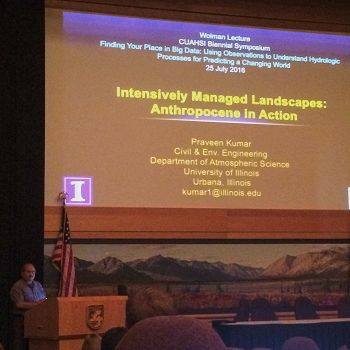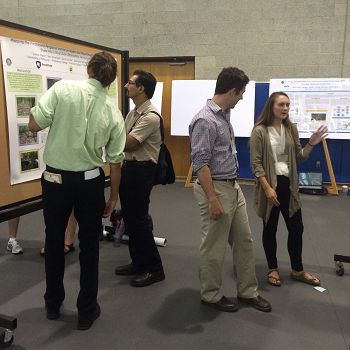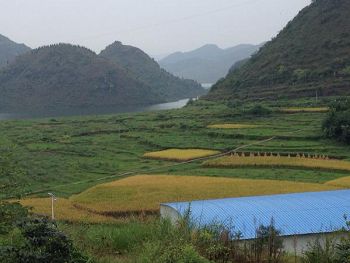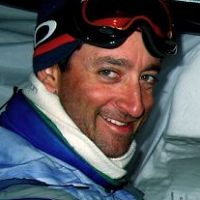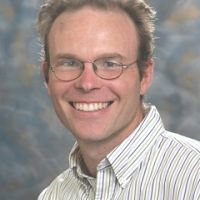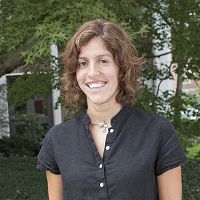CZNews: Fall 2016
Print Verison: CZNews - Fall 2016 (1 MB PDF)
Hydrologic Partitioning Across the CZO Network
A deeper understanding is needed regarding how variations between co-evolved Critical Zone (CZ) architectures lead to variations in fluxes delivered to streams. Noah Molotch (CU Boulder) and Ciaran Harman (Johns Hopkins U) are leading a cross-CZO intercomparison project of how CZ physical, chemical, and biological structure determines stream flow quantity and composition. Previous works have inferred the function of CZ structure by studying the integrated response of stream flow quantity and chemistry, but those analyses are limited in considering CZ structural complexity. The project will address two fundamental questions: 1) How does CZ structure influence hydrologic processes and functions? 2) Do hydrologic processes and CZ structure co-evolve? To accomplish this, a project post-doc will first collate and analyze CZO hydrologic data and help develop perceptual models of each CZO’s internal structure to determine how each site functions hydrologically. Molotch and Harman suggest that understanding the relationship between CZ structure and hydrologic storage is an essential step toward answering broader questions about chemical and biological structure and fluxes. The project was funded by the National Science Foundation (NSF), the CZO SAVI project, and the CZOs. An appointed cross-site working group will facilitate communication and collaboration between this project and the CZOs.
CZO PI Meeting at Reynolds Creek
The Reynolds Creek CZO (RCCZO) hosted a site visit on September 18-21 in Boise, Idaho. One PI and another investigator attended from each CZO along with representatives from the NSF including CZO program director Richard Yuretich. Attendees met on Day 1 to discuss network accomplishments and to organize for the upcoming 2-day network review at the NSF in mid-November. This conversation carried into Day 2 at Boise State University with talks on the state of the CZO Network, National Office, data management, education and outreach, and cross-CZO projects. Day 2 ended with an introduction to RCCZO’s research, highlights, and outreach efforts. Attendees toured RCCZO on Day 3. A sunny day was spent making numerous stops at field and instrumented sites within the Reynolds Creek watershed. Tour topics included an RCCZO overview (Mark Seyfried), soil carbon and soil depth (Nick Patton) rain/snow transition (Sarah Godsey), and vegetation exclosures and monitoring (Patrick Clark). On the final day, PIs met at the USDA Agricultural Research Service office complex to discuss upcoming and future CZ papers, projects proposals, and cross-site collaborations. Thank you to all who planned, presented and participated in a productive and informative site visit!
Strategic Plan Webinar
An all-hands webinar entitled "Introduction to the CZO Network Strategic Plan,” was held on August 26 hosted by Susan Brantley (PSU) and William McDowell (UNH). The CZO strategic plan was developed by the CZO PIs, National Office staff, and the Steering Committee chair at a strategic planning workshop in Boulder, CO during February 2016. The informational webinar explained each component of the plan and what the network is doing to accomplish the goals. In attendance for the webinar were 54 participants from the greater CZO community, who provided input and feedback on the strategic plan. The webinar recording, slide presentation and the CZO strategic plan can be found on CriticalZone.org.
Upcoming Events
- CZO network review: November 14-15, Arlington, VA
- CZO International Workshop: December 11, San Francisco, CA
- AGU Fall Meeting: December 12-16, San Francisco, CA
- AGU Chapman Conference: January 22-27, 2017, San Juan, Puerto Rico
- 2017 CZO All-Hands Meeting: June 5-6, Arlington, VA
CZO Spotlight: Forecasting the response of Earth’s surface
Human health, safety, and resource sustainability rely on the Earth scientific community’s ability to forecast Earth’s response to climatic and land use changes (C&LUC). In the AGU journal Earth’s Future (July 2015), Jon Pelletier (U Arizona) et al. published “Forecasting the response of Earth’s surface to future climatic and land use changes: A review of methods and research needs.” The authors call Earth-surface scientists (ESS) and Earth-system modelers to collaborate to build the next generation of Earth System Models (ESMs) to reflect local surface processes. Current global ESMs capture key atmospheric and oceanic processes, but have simplified representations of many Earth-surface processes and characteristics. The ESS community works to develop conceptual and mathematical response models of the land surface, but at the local and regional scale. Authors note that such collaboration will require the ESS community to do more basic research and improve working at larger scales. Since many consequences of C&LUC will be felt locally, response models using local variations of the landscape will be essential tools for proper resource and land management.
CZO at CUAHSI Biennial
The CUAHSI Biennial Colloquium was held July 24-27 at the National Conservation Training Center in Shepherdstown, WV. CZ science was represented among community attendance, presentations, and posters. IML CZO PI Praveen Kumar (UIUC) was invited to give the Wolman Lecture entitled “Intensively Managed Landscapes: Anthropocene in Action.” Kumar walked the audience through how carbon, energy, soil/sediment, water, nutrients, and ecology are linked within an agricultural landscape. He went on to discuss how socio-economic driven inputs and modifications of such constituents are directed at overcoming the natural rates influenced by climate for the enhancement of landscape productivity. Kumar’s lecture can be viewed here. Kamini Singha (CSM) presented “Subsurface Imaging of the Critical Zone”, where she described “Robo-tree”, a highly instrumented tree within the Boulder Creek CZO, in an effort to use geophysics to map hydraulic distribution and functional root depth for a single tree. The CZO summer REUs and RETs from Penn State and Stroud Water Research Center also presented posters during the Biennial’s poster session. These posters are available at czo.stroudcenter.org.
NERC-NSFC CZO Program
The U.K’s Natural Environment Research Council (NERC) in collaboration with the National Natural Science Foundation of China (NSFC) has agreed to fund five projects under the joint NERC-NSFC program 'Using Critical Zone Science to understand sustaining the ecosystem service of soil and water'. This program brings together researchers from the two countries to undertake integrative research within the CZ to understand the functioning of soil and water systems and their resilience to change in relation to key ecosystem services such as food, clean water, and climate mitigation in China. The following funded projects are each led by PIs from the UK and China:
- The Transmissive Critical Zone: understanding the karst hydrology- biogeochemical interface for sustainable management
- Modelling and Managing Critical Zone Relationships between Soil, Water and Ecosystem Processes across the Loess Plateau
- Using Critical Zone Science to Enhance Soil Fertility and Improve Ecosystem Services for Peri-Urban agriculture in China
- Red Soil CZ: From Natural to Anthropogenic Evolution of Red Soil and its Impact on Ecosystem Function in the Critical Zone
- SPECTRA: Soil Processes and Ecological Services in the Karst Critical Zone of SW China
The U.S. CZO Program’s support of CZ science as a collaborative and cross-site effort continues to engender development of a similar approach internationally. Follow these projects’ progress on Twitter: @UKChinaCZO.
CZNews
Receive the CZO Email Newsletter
Occasional email will include news, events, and other info related to Critical Zone Observatories.
We hate spam as much as you do, so your information will never be shared. You can unsubscribe at any time.
U.S. CZO network
Reynolds Creek CZO Tour
Earth's Future, July 2015 cover
Preveen Kumar presenting at CUAHSI Biennial.
CZO REUs Conner Martin (University of Pittsburgh) and Catherine Medlock (University of Delaware) presenting thier summer research at the CUAHSI Biennial.
Red Soil CZO Photo: Dan Richter
The Critical Zone. Illustration modified from Chorover, J., R. Kretzschmar, F. Garcia-Pichel, and D. L. Sparks. 2007. Soil biogeochemical processes in the critical zone. Elements 3, 321-326. (artwork by R. Kindlimann).
News Category:
RESEARCH |
PUBLICATIONS |
PEOPLE
People Involved
CZO
-
Boulder, Sierra, INVESTIGATOR
-
Christina, INVESTIGATOR
-
National, Eel, Luquillo, Shale Hills, INVESTIGATOR, COLLABORATOR
-
Luquillo, INVESTIGATOR
-
Catalina-Jemez, INVESTIGATOR
-
IML, INVESTIGATOR
-
Boulder, Shale Hills, INVESTIGATOR
Related News
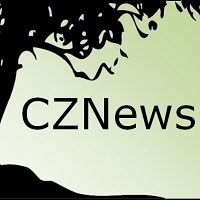
CZNews: Summer 2016
24 Jul 2016 - CZO Newsletter CZNews: Summer 2016

CZNews: Spring 2016
13 Apr 2016 - The CZO National Office Newsletter CZNews: Spring 2016

CZNews: Winter 2016
11 Jan 2016 - The CZO National Office Newsletter CZNews: Winter 2016

CZNews: Fall 2015
01 Oct 2015 - The CZO National Office Newsletter CZNews: Fall 2015

CZNews: Summer 2015 is here!
01 Jul 2015 - Check out the summer edition of the CZO National Office's quarterly newsletter CZNews!

Introducing a CZO Newsletter: CZNews
30 Mar 2015 - The CZO National Office introduces a quarterly newsletter: CZNews!
Explore Further

